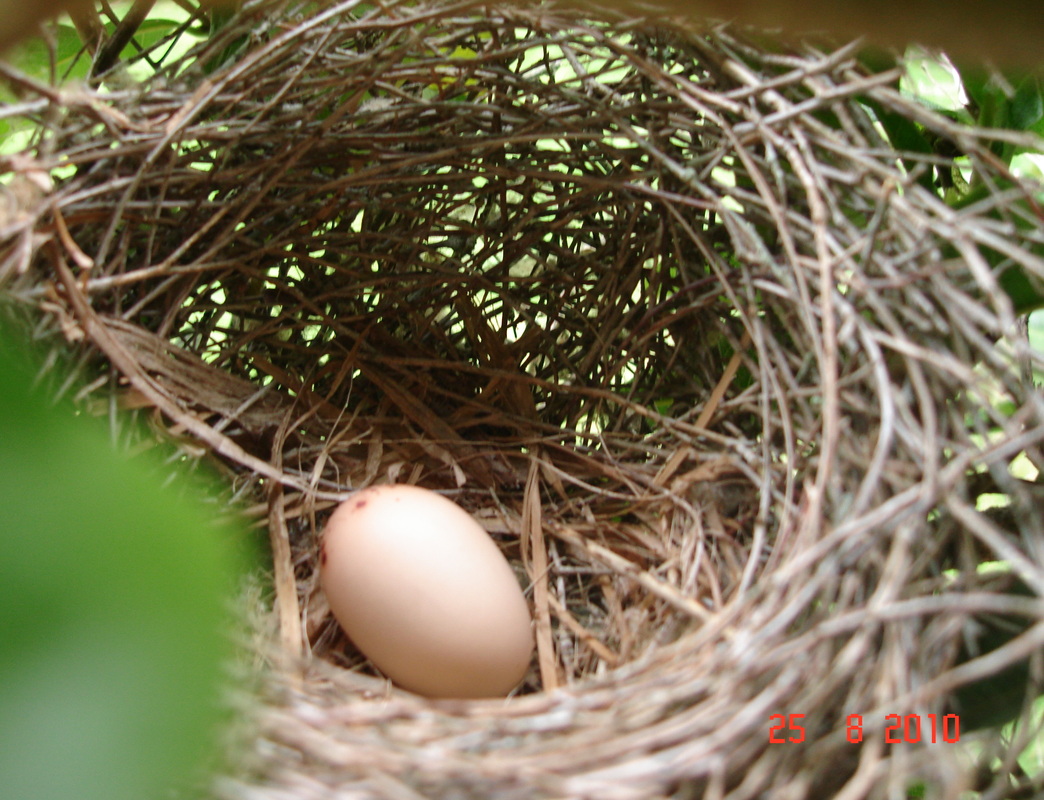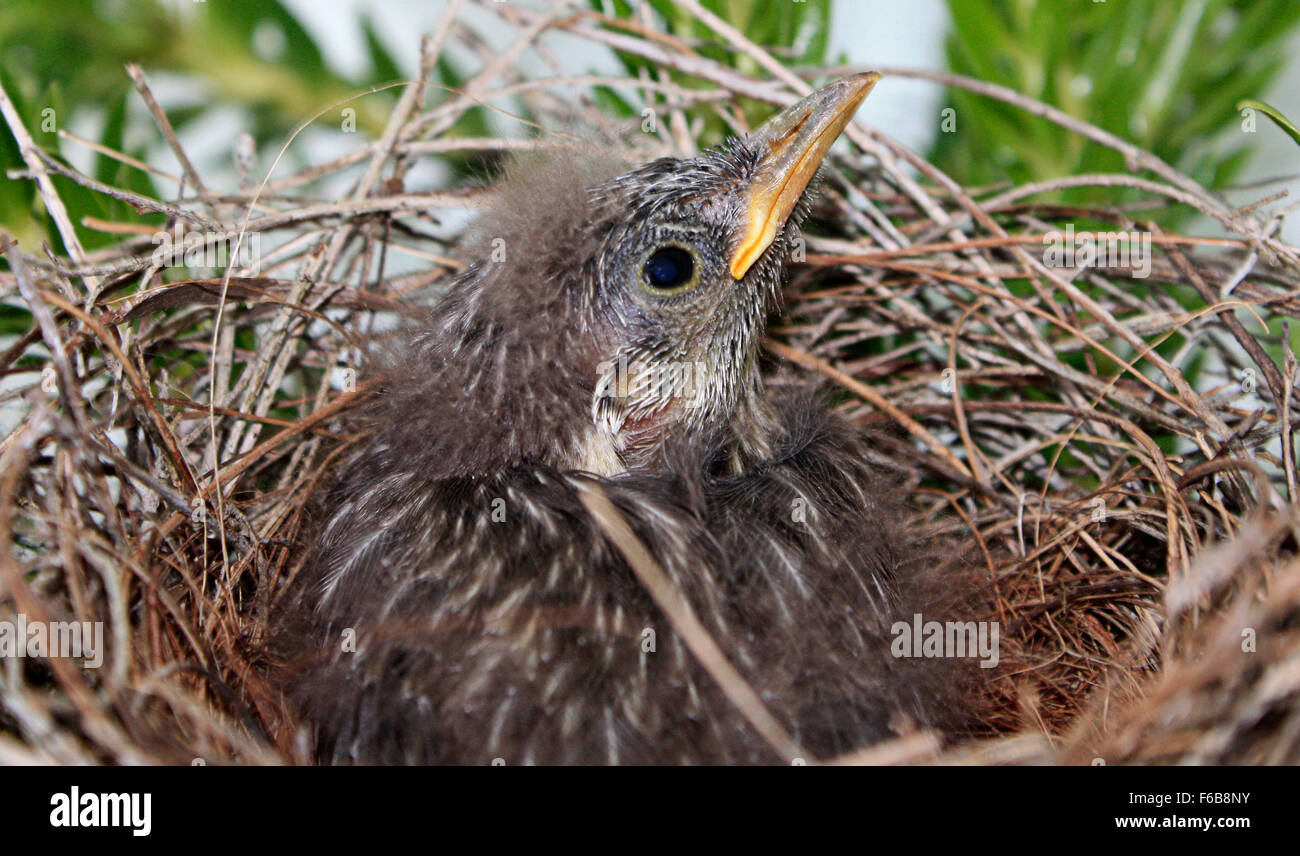sunshinecoastbirds Nestling Musings Do Australian Bushbirds Commit Siblicide?
Birds may feed alone or in small to large groups. Breeding behaviours. If conditions are suitable as many as three broods may be raised in a year. The female Little Wattlebird normally constructs the nest, which is a large cup of twigs and grass, lined with soft materials, such as feathers and wool.

Wattlebird Adelaide Ornithologists' Club
The Red Wattlebird is a large, noisy honeyeater. The common name refers to the fleshy reddish wattle on the side of the neck. The plumage is grey-brown on the body, with prominent white streaks and yellow on the belly. The face is pale and the tail is long with a white-tip. Young Red Wattlebirds are duller than the adult and have a brown.

Bird nest stock photo. Image of bird, wattle, twigs 156858150
Breeding takes place from June to December. The female wattlebird generally constructs the nest, which is a loose, untidy cup of twigs, lined with shredded bark, and placed from 1 to 10 m high in the fork of a banksia, tea-tree or eucalypt sapling. 1-2 eggs are laid and may be spotted red-brown, purplish-red or salmon-pink in colour.

Baby wattlebird. The mother took two weeks to build the nest. She sat on it for over two weeks
Red Wattlebird. I was quietly having my breakfast this morning when a Red Wattlebird flew into the bush near our sun room. It proceeded to pull off a small twig from a Melaleuca bush. It then flew off rapidly to a Eucalyptus tree next to the driveway. Less than a minute later it was back again, swinging on a small twig until it was dislodged.

Newborn bird nest hires stock photography and images Alamy
Medium-large honeyeater found in southwestern Australia, typically in scrub and dry coastal woodlands. Grayish brown overall with fine white streaking; pale tips to tail feathers and chestnut in primary feathers most easily observed in flight. Easily distinguished from Red Wattlebird by the lack of pink wattles below the eye and the lack of yellow lower belly. Often found near flowering.

Large Bird Nest Knitted from Wattle, Nusa Penida, Indonesia Editorial Photo Image of indonesia
Birds may feed alone or in small to large groups. Breeding: If conditions are suitable as many as three broods may be raised in a year. The female Little Wattlebird normally constructs the nest, which is a large cup of twigs and grass, lined with soft materials, such as feathers and wool. The nest may be placed in a range of places from the.

Wattle Bird Eggs.... Beautiful birds, Bird eggs, Pet birds
Little wattlebird. Unlike most wattlebirds this bird lacks the visible wattles hanging from its cheeks. It is about 30 centimetres long, with blue eyes, mostly dark grey-brown above with white streaks, and a paler grey with white streaks below. Although not the most colourful of birds themselves, little wattlebirds love colourful flowers so.
sunshinecoastbirds Nestling Musings Do Australian Bushbirds Commit Siblicide?
The red wattlebird (Anthochaera carunculata) is a passerine bird native to southern Australia. At 33-37 cm (13-14+1⁄2 in) in length, it is the second largest species of Australian honeyeater.It has mainly grey-brown plumage, with red eyes, distinctive pinkish-red wattles on either side of the neck, white streaks on the chest and a large bright yellow patch on the lower belly.

Red Wattlebird feeding in makeshift nest YouTube
It is probably just fallen out. If it was unhealthy or in some way genetically defective, it would be unlikely the parents would still feed it (survival.of the fittest). Fledglings should be left to their parents to sort out, but this one is obviously too small, and as you suggest unlikely to survive cats or other predators (other birds for.
sunshinecoastbirds Nestling Musings Do Australian Bushbirds Commit Siblicide?
The female wattlebird generally constructs the nest, which is a loose, untidy cup of twigs, lined with shredded bark, and placed from 1 to 10 m high in the fork of a banksia, tea-tree or eucalypt sapling. 1-2 eggs are laid and may be spotted red-brown, purplish-red or salmon-pink in colour.

Red Wattlebird
Red Wattlebirds ( Anthochaera carunculata) are large honeyeaters easily identified by the fleshy reddish wattle on the side of their neck. They have grey-brown bodies with white streaks, a yellow belly and pale face. Baby Red Wattlebirds are duller in colour and have a brown eye instead of red like the ad.

RED WATTLEBIRD (ANTHOCHAEERA CARUNCULATA) CHICKS IN NEST, AUSTRALIA
RF2J19R1F - Red wattlebird (Anthochaera carunculata) adult bird collecting feathers for its nest, Kennett River, Victoria, Australia RF 2H1A5G0 - Close-up of Little Wattlebird nestlings (Anthochaera chrysoptera), South Australia

Quick Facts about Bird Nests Birding World
Yellow wattlebirds nest in breeding pairs and aggressively defend their territories from other birds. The nest of the yellow wattlebird is made by the female alone, and is a large, open saucer-shaped structure made of twigs and bark that are bound by wool. The inside of the nest is lined with wool and grass.

Red Wattle Birdsanthochaera Carunculata Barkingbird Gillbird Stock Photo 2094544777 Shutterstock
Breeding. The Yellow Wattlebird nests in breeding pairs that aggressively defend their breeding territories against other birds. The female alone constructs the open, bowl-shaped nest of thin twigs, bark and grass, lining it will bark, roots, grass and mammal fur or wool.

Birds as wattle pollinators — Life in a Southern Forest
The Red Wattle Bird in particular has a nest that is not all that big just a few twigs and bark placed in the fork of a branch. Generally the bird lays 2 or 3 eggs and the eggs seem quite large for a bird of it's size. The egg of a Wattle Bird measures around 36mm x 22mm.

Little wattle bird nest and egg During a break on our walk… Flickr
The red wattlebird (Anthochaera carunculata) is a passerine bird native to southern Australia. At 33-37 cm (13- 14 + 1 ⁄ 2 in) in length, it is the second largest species of Australian honeyeater.It has mainly grey-brown plumage, with red eyes, distinctive pinkish-red wattles on either side of the neck, white streaks on the chest and a large bright yellow patch on the lower belly.